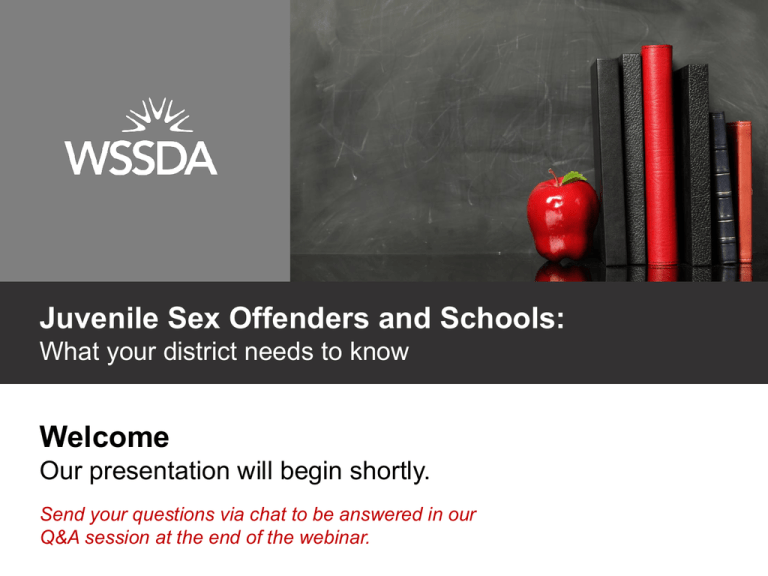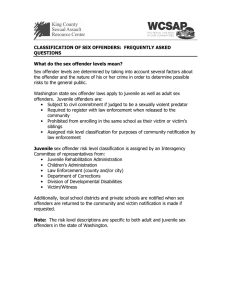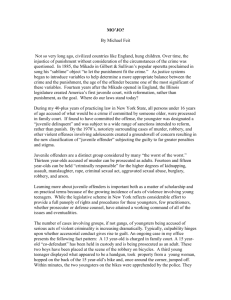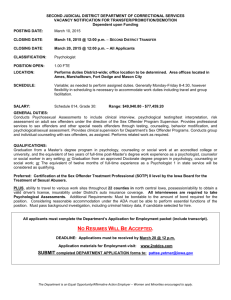Juvenile Sex Offenders and Schools
advertisement

Juvenile Sex Offenders and Schools: What your district needs to know Welcome Our presentation will begin shortly. Send your questions via chat to be answered in our Q&A session at the end of the webinar. 12:00 p.m. Welcome and introductions 12:03 p.m. Juvenile sex offenders in schools ▪ ▪ ▪ ▪ ▪ Legal overview Who are the juvenile sex offenders? Lessons learned Revised policy on JSO notification: what’s new? Effective safety planning 12: 45 p.m. Q&A Presented by: Heidi Maynard, WSSDA; Kathleen Sande, OSPI; and Dawn Larsen, WASPC Nothing in this presentation should be considered legal advice. No information in this presentation represents the position of WSSDA, OSPI or WASPC on any specific legal matter. Your district should seek professional legal counsel before acting upon any information in this presentation. Constitutional Provisions U.S. Constitution /14th Amendment Washington Constitution, Article XXVI, Compact with the United States (Fourth) Washington Constitution, ARTICLE IX, Section 1 Statutory and Rule Provisions District responsibility: RCW 28A.150.210 Basic education – Goals of school districts. WAC 392-400-215(1) Student responsibility: RCW 9A.44.130 (1)(b)(i) Exception: Juvenile Court Act RCW 13.40.215(5) Upon discharge, parole, transfer to a community residential facility, or other authorized leave or release, a convicted juvenile sex offender shall not attend a public or approved private elementary, middle or high school that is attended by the victim or a sibling of a victim of the sex offender. Typically between the age of 13 and 17 Generally male 30-60% exhibit learning disabilities and academic dysfunction Up to 80% have a diagnosable psychiatric disorder Difficulties with impulse control and judgment 20-50% have histories of physical abuse 40-80% have histories of sexual abuse CSOM, “Myths and Facts About Sex Offenders: Statistic and Characteristics of Adult and Juvenile Offenders, available on CSOM website (http://www.csom.org) They have significant problems in the following areas: Social skills Peer relationships Social isolation Academic difficulties They often have lower incidents of drug and alcohol abuse and other criminal behaviors. Juvenile sexual abusers have higher rates of: Depression and mental health problems Health problems at an earlier age Fire setting and running away Hyperactivity and restlessness Sexual victimization Schwartz, Barbara K. and Cellini, Henry R. (1995). The Sex Offender: Corrections, Treatment and Legal Practices. 6, 1-11. The median age of offenders is 14 to 15. The median age of the victim is 7. Average number of victims is 7. Over 90% of sex offenses involved a victim the offender knew. Most attend school and achieve at least average grades. 25 to 33% have neurological impairment. Among other things, they are tall, short, heavy, thin, humorous, serious, challenged, ambitious, curious and resemble other peers their age. Washington State Dispositions for Juvenile Sex Offenses ‘08 – ‘10 LS SSODA JRA 2008 90 145 132 2009 80 129 123 2010 77 114 87 180 160 140 120 100 80 60 40 20 0 164 106 JRA In residence JRA Parole Data taken from Automated Client Tracking System 10/2013 ESSB 6580 required OSPI to convene a workgroup in 2006: To develop a model policy for school principals receiving sex offender notifications To provide safer school communities To encourage principals to develop working relationships with local law enforcement Importance of School-Law Enforcement Relationship ESSB 6580 Recommendations: Both principals and superintendents need notifications Board policies are needed in all districts (no matter if they never have had a sex offender) Local law enforcement encouraged to work closely with school principals When school staff work collaboratively with law enforcement = safer schools & communities In 2012, SSB 5204 required the revised policy: Clarified Superintendent responsibilities Re-stated responsibilities of Principals Added Student Safety Planning based upon Harassment-Intimidating-Bullying protocols Added Model Safety Plan template Added checklists for the safety meetings Step 3: Step 2: Step 1: • student registration as a Level I, II or II enrolling in attending school OR • when a student’s risk level changes OR • when Sheriff is notified of student change of address • Level I Offender: school personnel who, in their judgment, for security purposes, should be aware of the student’s records. • Level II or III Offender: every teacher of that student plus any other school personnel who, in their judgment, should be aware of the student’s record. • Kidnapping Offenders: case-by-case basis. Development Implementation Heidi Maynard, JD Director of Policy and Legal Services, Washington State School Directors’ Association 221 College Street NE Olympia, WA 98516 360-252-3017 h.maynard@wssda.org Kathleen O’Neill Sande Institution Education Program Supervisor, Office of Superintendent of Public Instruction PO Box 47200 Olympia, WA 98504 360-725-6046 kathleen.sande@k12.wa.us Dawn Larsen Director of Projects, Washington Association of Sheriffs and Police Chiefs 3060 Willamette Drive NE Lacey, WA 98516 360-486-2419 Dlarsen@waspc.org





